MUMMERS THEATER (THE STAGE CENTER THEATER) OKLAHOMA CITY, OKLAHOMA
ON ORGANIZATION AND ORDER
[I am reminded] of Louis Kahn's statement that at a certain point in the design and development of a building, the building turns back on the architect and determines how it wants to be finished. It becomes a living element, a personified partner in the design process.
In the case of the Oklahoma [Mummers] Theatre, the organization is not compositional in the conventional sense, but has an order that is adopted from the electronic organization of elements.
The basis is the chassis, and the components and sub-components are attached to them, which of course are serving elements for the major components. Then there is the harnessing and the communications system, which are for circulation. This freed me in my thinking, just by its pure terminology, to organize the building. I think that's unique and hope it's original in the sense of going into an organization that is adopted from another field of endeavor. Otherwise there is no organization there, and it looks like chaos. I was very proud to have it look like chaos!
You pass between certain forms that relate to each other and in turn to the organization - one on the left and one on the right relate to the organization, so it's a tripartite organization with three different centers of order.
- John M Johansen interview with Hans Ulrich Obrist
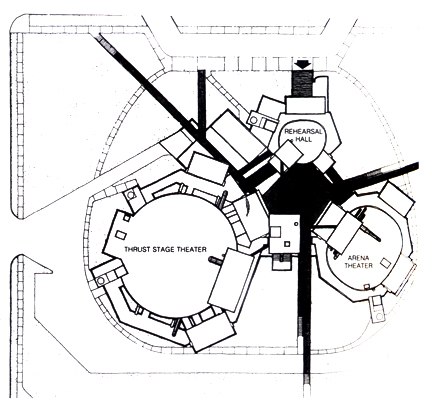
This new position is one which is concerned not with gestural form and with masterworks of architecture, but rather with processes, with action, with behavioral patterns, and how most simply all these may be expressed. This new position does not attempt to define a new architecture, but settles for something more humble yet fundamental, expressed by Peter Cook simply as new ' organizing ideas' or ' ordering devices.' The idea or device will derive from motivating processes-processes of newly recognized societal behavior, and of highly industrialized building techniques, Advocates of this position, Archigram and the Metabolists, will strive to reconcile these now more carefully examined living patterns with new technology.
Website Copyright © 2011 John M Johansen All Rights Reserved
No information, photos, videos or audio on this website may be distributed, copied
or otherwise used without the written permission of John M Johansen or his representative
Website created by John Veltri and Marguerite Lorimer EarthAlive Communications www.earthalive.com
Please direct inquires to info@earthalive.com
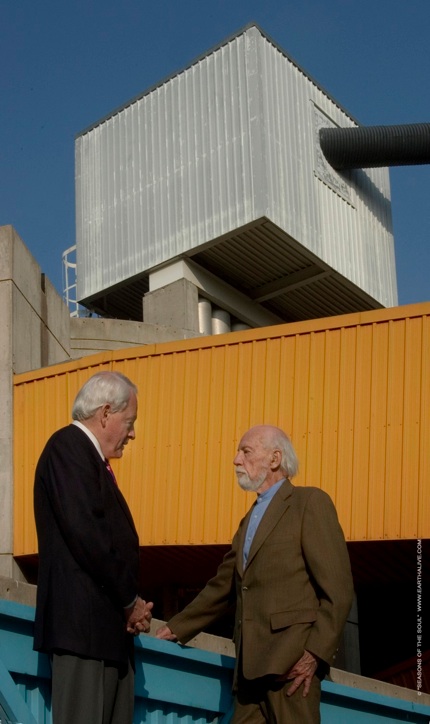

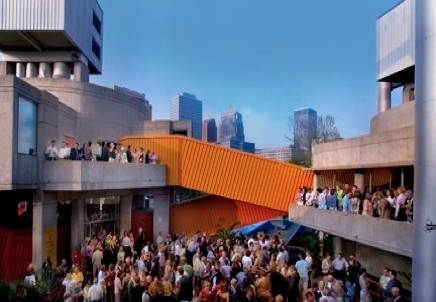
Disdain for Establishment Modern
Johansen comments on the Moholy-Nagy article, "The Mummers Theater: A Fragment, Not a Building" (1968):
[This building] conveys the rebellious spirit I experienced at that time, which further encouraged me to trust and rely upon my own originality in designs of buildings to follow. The Beaux Arts is still very much with us. Nearly all the major buildings currently designed and built in the United States, and each year honored by our profession, are conceived according to those standards and values which we thought we had discarded after the architectural revolution of the 1920s and 1930s. Whether classically geometric or romantically amorphous, most of the work by architects, including myself, over the past ten years has been faithful to that old tradition which would have us concern ourselves with the 'tasteful arrangement of compositional elements.' The 'form giving' period is waning. Although one can still make convincing distinctions between the forms of neo-classicists like Johnson, Yamasaki, Stone, or SOM, on the one hand, and on the other hand, the more picturesque designers like Kahn, Rudolph, Giurgola, Venturi, or myself, there is really very little difference between them all; we have all come from the same bag, when our work is seen from the vantage point of a totally new formative position now being established.














Brash and incisive at first sight, it does not look like a theater at all. Johansen designed it in terms of distinct units - blocks of raw concrete with brightly painted steel cladding, connected by tubes and catwalks. Nothing could be more remote from the idiom of the theater as temple with massive portico and formidable foyer suggesting, in the manner of Lincoln Center, that the audience is going to be vouchsafed a peek at the altar of some crushing god named High Culture. The Mummers Theater, by contrast, with its simple scale, does not try to stimulate the audience’s sense of self-importance; it is entirely directed toward the events on stage. It is literally a playhouse - open, light, improvisatory, gamelike. Oklahoma City’s more conservative people dislike the Mummers Theater because it reminds them of a factory. It is an exquisitely human building in its scale, organization and intriguing unpredictabilities.
The circuiting is intricate and made up of five subcircuits: (1) a corridor layout within the base connecting all understage areas; (2) a confluence of paths by means of bridges connecting the sidewalks over the roof of the base to the public gardens; (3) the automobile circuit passing under these bridges, connecting entrances, parking, and service; (4) the theatergoer’s tube system which leads from ticket office and lobby to the three theaters and to ‘seating trays’; (5) the overhead distribution of chilled water from the cooling towers to the three air conditioning units above each theater. - John M Johansen FAIA
TIME MAGAZINE: Robert Hughes “Toward a New Slang” (1971)


Save the Mummers (Stage Center) Theater interview with Frank Gehry

New Organizing Ideas
When invited by Oklahoma City Arts Council Director James Tolbert (above) to revisit
the building in 2008 and attend the Oklahoma City Festival of Arts Reception, held each year
in the Mummers [Stage Center] Theater, then-92 year-old Johansen flew from New York
to Oklahoma City by himself to participate in the event. A grand party, held throughout
the vibrant Theater complex during the event, was attended by
over 1000 arts and architecture enthusiasts (above)
2008 at the Mummers [Stage Center] Theater
John M Johansen talks with Theaters Supporter James Tolbert
Elevations, if one can say they exist, cannot be drawn or studied; in fact, facets of wall, roof, and soffit are so numerous, with interface so prevalent, that their relationships may as well be left to chance. In fact, among the contract documents, I provided only plans and sections; elevations, impossible to draw, were not yet provided. Facets, not facades, result in bombardment of composite images; yet they are held together by the ordering device. - John M Johansen
BOMBARDMENT OF IMAGES
The first sketches for the Mummers Theater were made as early as 1965, while construction was not completed until 1970. These four preparatory years were devoted to research, pondering, sketching, and experimenting in an effort to devise a new organization for buildings that was inspired from electronics. In “The Mummers Theater: A Fragment, Not a Building,” the application of the order of electronic systems is described: “In the design of the Oklahoma Theater Center in Oklahoma City, the three theaters comprise the major components - lounges, offices, toilets - attached to the, The three components are plugged into a supporting base or ‘chassis.’
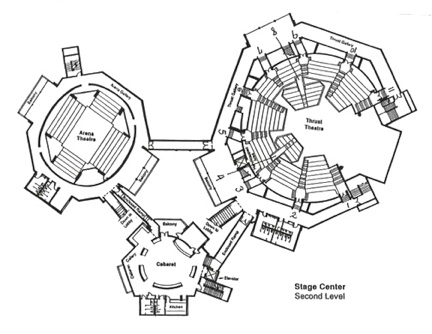
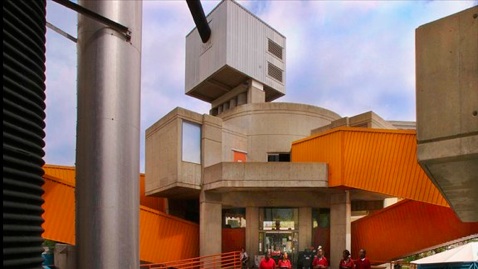
Architecture, as we know it, is less and less a determinant in the organization of our buildings, of building complexes, or of cities. It is no longer effective in its solutions, nor even compelling in its esthetic expression. Formalism, centrality, ordered sequence, and the design of isolated unrelated buildings cannot deal with the demands that the urban problems are now making upon the profession. - John M Johansen
In the video (above) Johansen discusses the process of creating the Mummers.
John M Johansen ushered in a new era of architecture in 1970 in Oklahoma City with his radical Mummer’s Theatre (later known as the Stage Center). Johansen, who received the prestigious American Institute of Architects Honors Award for his design, incorporated two major influences in his design - brutalism and systems theory - to create one of his most successful projects. “My purpose was to excite, intrigue, tempt, and entrap. In the Mummers Theater, theater goers are drawn into a building as stage set and feel themselves actors among professionals on the stage itself, in a total, combined performance. As I like to make the analogy, such buildings are like artful, subtle women who, offering love, do not give themselves, but ask to be taken.” - John M Johansen FAIA
Brutalizing Brutalism: Why John M. Johansen's Crumbling Concrete TheaterS Should be Saved
by Kelly Chan May 22, 2012 http://www.blouinartinfo.com/news/story/805003/brutalizing-brutalism-why-john-m-johansens-crumbling-concrete
Was Stage Center's fate cast with 1968 unveiling?
Oklahoma business writer Steve Lackmeyer, Johansen architecture advocate and also the author of five books on Oklahoma City history, delves into why Stage Center was doomed before it was built. - from The Oklahoman
http://newsok.com/was-stage-centers-fate-cast-with-1968-unveiling/article/3941906
“Johansen was challenging conventionality. He was breaking the rules and forcing the design world to rethink the possible. It is men like Johansen who inspire later visionaries like Steve Jobs. They force the world to evolve — even when its not ready to embrace such change.” - Steve Lackmeyer